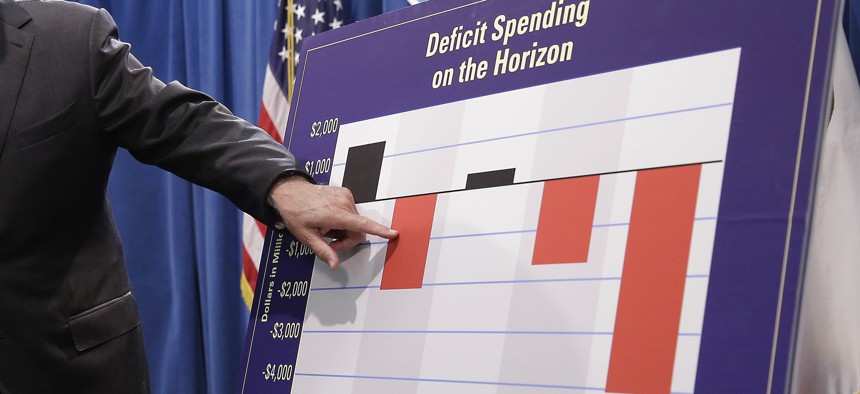Federal Watchdog Offers Gloomy Outlook for State and Local Budgets

In this May 13, 2016, file photo, California Gov. Jerry Brown gestures to a chart showing possible future deficit spending as he discusses his revised 2016-17 state budget plan in Sacramento, Calif. AP Photo/Rich Pedroncelli, File

Connecting state and local government leaders
U.S. Government Accountability Office estimates show mounting fiscal pressures over the next 50 years.
State and local government spending is likely to increasingly outpace revenues over the next half-century, based on projections a federal watchdog issued on Thursday.
Health care costs, in particular Medicaid, which is the health insurance program for poor Americans, along with benefits for public retirees and employees, will be major contributors to the rise in expenditures, according to the Government Accountability Office.
The GAO's findings are based on simulations it has published for about a decade now looking at long-term state and local fiscal trends.
Past reports have also shown that the sector is poised to face budget-related stress over the long term.
The latest simulations indicate that revenues from personal income taxes and federal grants to state and local governments will rise in the years ahead, but at a slower clip than expenditures.
"The sector faces a declining fiscal outlook," GAO's report says.
"Absent any policy changes," the report adds, "revenues are likely to be insufficient to maintain the sector’s capacity to provide services at levels consistent with current policies during the next 50 years."
One indicator GAO looks at is "operating balance"—a measure of the state and local sector's ability to cover operating expenses in a given year with operating revenues collected in that year.
By 2067, the agency predicts that the sector's negative operating balance (meaning costs are exceeding revenues) will reach a level that's in the ballpark of 3 percent to 3.5 percent of U.S. gross domestic product.
That's compared to a negative balance last year of about 1.3 percent of U.S. economic output. Total GDP last year was around $19.5 trillion.

Most states have balanced budget requirements. And GAO explains that its operating balance calculations don't incorporate reserve funds and certain other budget actions used to deal with revenue shortfalls.
Health care expenditures by the state and local government sector are projected to rise from about 4.1 percent of the nation's GDP in 2018 to 6.3 percent of GDP in 2067, the report says.
GAO makes certain assumptions to produce the findings in the report, including that the federal government, states and localities continue to provide services at levels in line with where they are now.
The report does not provide a fiscal outlook for individual places, but rather aggregate projections for the state and local sector.
A fully copy of the GAO findings can be found here.
Bill Lucia is a Senior Reporter for Government Executive's Route Fifty and is based in Washington, D.C.

NEXT STORY: The Reason Why Kentucky’s Pension Reform Law Was Struck Down





